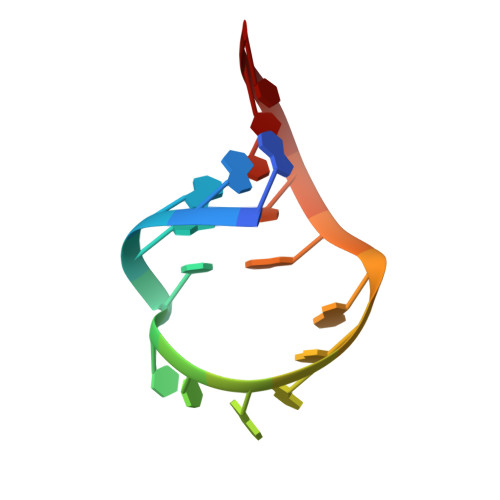NMR structure of a kissing complex formed between the TAR RNA element of HIV-1 and a LNA-modified aptamer
Lebars, I., Richard, T., Di Primo, C., Toulme, J.J.(2007) Nucleic Acids Res 35: 6103-6114
- PubMed: 17768146
- DOI: https://doi.org/10.1093/nar/gkm655
- Primary Citation of Related Structures:
2OOM, 2PN9 - PubMed Abstract:
The trans-activating responsive (TAR) RNA element located in the 5' untranslated region of the HIV-1 genome is a 57-nt imperfect stem-loop essential for the viral replication. TAR regulates transcription by interacting with both viral and cellular proteins. RNA hairpin aptamers specific for TAR were previously identified by in vitro selection [Ducongé,F. and Toulmé,J.J. (1999) In vitro selection identifies key determinants for loop-loop interactions: RNA aptamers selective for the TAR RNA element of HIV-1. RNA, 5, 1605-1614]. These aptamers display a 5'-GUCCCAGA-3' consensus apical loop, partially complementary to the TAR one, leading to the formation of a TAR-aptamer kissing complex. The conserved GA combination (underlined in the consensus sequence) has been shown to be crucial for the formation of a highly stable complex. To improve the nuclease resistance of the aptamer and to increase its affinity for TAR, locked nucleic acid (LNA) nucleotides were introduced in the aptamer apical loop. LNA are nucleic acids analogues that contain a 2'-O,4'-C methylene linkage and that raise the thermostablity of duplexes. We solved the NMR solution structure of the TAR-LNA-modified aptamer kissing complex. Structural analysis revealed the formation of a non-canonical G*A pair leading to increased stacking at the stem-loop junction. Our data also showed that the introduction of LNA residues provides an enhanced stability while maintaining a normal Watson-Crick base pairing with a loop-loop conformation close to an A-type.
Organizational Affiliation:
CNRS-Université Bordeaux 1-ENITAB, UMR 5248 CBMN, Institut Européen de Chimie et Biologie, Pessac, F-33607, France. i.lebars@iecb.u-bordeaux.fr















